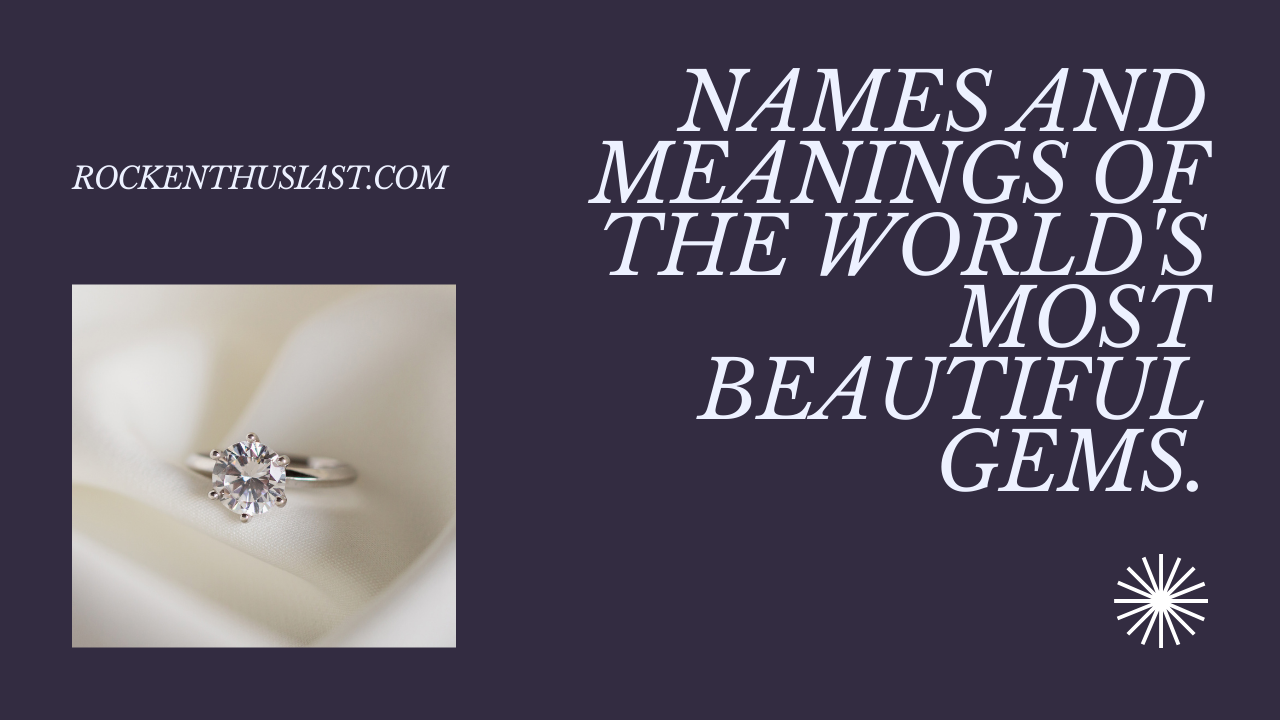Welcome to our blog, where we delve into the fascinating world of precious stones and explore the meanings behind their names. For thousands of years, humans have been captivated by the allure and beauty of these rare gems. From diamonds to sapphires, emeralds to rubies, each stone possesses its own distinctive qualities that make it truly unique.
But have you ever wondered why these precious stones are called what they are? Behind every name lies a rich history, a symbolism that has been passed down through generations. In this article, we will take a closer look at the names of precious stones and uncover the intriguing meanings hidden within.
Whether you are a gemstone enthusiast or simply curious about the stories behind these shimmering treasures, join us as we embark on a journey through the origins and significance of some of the most coveted stones on Earth. From the ancient beliefs and legends associated with these stones to the modern interpretations they hold, we will explore the multifaceted meanings that make them so cherished.
So, let’s dive into the enchanting world of precious stones and discover the profound significance they carry. Get ready to be captivated by the beauty and mystique of these gems as we unravel the secrets behind their names. Join us on this enlightening exploration of the Names Of Precious Stones And Their Meanings.
The Timeless Elegance of Diamonds: Symbolism and Meaning

Names Of Precious Stones And Their MeaningsDiamonds have long been coveted for their timeless elegance and beauty. But beyond their captivating sparkle, diamonds are also rich in symbolism and meaning. In fact, the names of precious stones often hold significant connotations that can add a deeper layer of significance to these dazzling gems.
The word “diamond” itself derives from the Greek term “adamas,” meaning unconquerable or invincible. This reflects the diamond’s durability and strength, making it an enduring symbol of resilience and power. Throughout history, diamonds have also been associated with love and fidelity. They have become a popular choice for engagement rings, symbolizing the unbreakable bond between two individuals.
Furthermore, diamonds hold spiritual significance in many cultures. In Hinduism, for instance, diamonds represent the third eye of Lord Shiva, signifying wisdom and enlightenment. In the realm of astrology, the diamond is believed to enhance the wearer’s positive traits and ward off negative energy. Its clarity and brilliance are seen as reflections of the soul, embodying purity and truth.
While diamonds are admired for their allure and rarity, their deeper meaning adds a touch of mystique to these precious stones. Whether it is their association with love, power, or spirituality, diamonds continue to fascinate and captivate us with their timeless elegance. So next time you gaze upon a diamond, take a moment to appreciate the wealth of symbolism and meaning that lies within this extraordinary gem.
Uncovering the Vibrant Energy of Emeralds: Symbolic Significance
Emeralds, often referred to as the “jewels of spring,” have captivated humanity for centuries with their mesmerizing beauty and rich green hue. Beyond their aesthetic appeal, these precious gemstones hold deep symbolic significance in many cultures and beliefs. In fact, the name emerald itself is derived from the Greek word “smaragdus,” meaning green stone.
Throughout history, emeralds have been associated with various meanings and virtues. In ancient Egypt, they were considered a symbol of fertility and rebirth. Egyptian pharaohs were often buried with emeralds to ensure eternal youth and vitality. In Greek mythology, the stone was connected to the goddess Venus, representing love, renewal, and harmony. The Romans believed that emeralds were linked to Mercury, the messenger of the gods, and bestowed the gem with attributes of wisdom and eloquence.
Emeralds also hold cultural significance in numerous countries and traditions. In Hinduism, these gemstones are believed to bring good fortune and are associated with the planet Mercury. In ancient Chinese culture, emeralds were seen as a symbol of wealth and prosperity. The indigenous peoples of South America revered emeralds as sacred stones, representing the lush greenery of the rainforest and the divine energy of nature.
Names of precious stones and their meanings can differ across cultures, but one thing remains constant: emeralds have long been revered for their vibrant energy and profound symbolism. Whether you view them as a representation of love, renewal, or abundant prosperity, the allure of these gemstones is undeniable. So, the next time you gaze upon an emerald, take a moment to appreciate the hidden meanings and centuries-old traditions that make these gemstones truly enchanting.
Pearls: Symbolism and Meaning Behind the Lustrous Gem
Pearls have long been known as a symbol of elegance and timelessness, adorning the necks of royalty and the wrists of the fashionable. But beyond their aesthetic appeal, pearls hold a deeper symbolism that adds to their allure. In fact, pearls are often associated with purity, wisdom, and wealth.
The symbolism of pearls originates from their unique creation process. Unlike other gemstones that are mined from the earth, pearls are formed within living creatures – oysters and mollusks. This natural process gives pearls a sense of purity and innocence, making them the perfect symbol for purity and wholeness.
Furthermore, pearls are often associated with wisdom and enlightenment. Their iridescent and lustrous appearance represents enlightenment and the journey towards knowledge. In many ancient cultures, pearls were believed to possess magical and healing properties, promoting balance and harmony in one’s life.
The association of pearls with wealth and luxury is also significant. The rarity of naturally occurring pearls and the labor-intensive process of harvesting them made them highly valuable throughout history. Pearls were often reserved for the upper classes, symbolizing their wealth and status. Even today, pearls are synonymous with sophistication and are favored by those who appreciate timeless beauty.
In conclusion, pearls have a rich symbolism that goes beyond their beautiful appearance. They represent purity, wisdom, and wealth, making them a cherished gemstone throughout history and in modern times. Whether gifted as a token of love or worn as a fashion statement, pearls continue to captivate and inspire with their enduring significance.
The Serene Beauty of Sapphires: A Look into their Symbolic Meanings
Sapphires, with their deep blue hues, have long captivated admirers with their serene beauty. These precious gemstones have a rich history and hold deep symbolic meanings in various cultures and traditions. Derived from the Greek word “sappheiros,” meaning blue, sapphires have been cherished for centuries for their association with wisdom, royalty, and divine protection.
One of the most famous historical references to sapphires is their connection to royalty. In ancient times, sapphires were believed to bring power and protection to kings and queens, symbolizing their authority and divine blessings. The British Crown Jewels, for instance, boast a stunning array of sapphire-studded ornaments, including the iconic engagement ring worn by Princess Diana and now proudly worn by Kate Middleton, Duchess of Cambridge.
Beyond their regal symbolism, sapphires have also been associated with wisdom and spirituality. Known as the “stone of wisdom,” these blue gems have been believed to enhance mental clarity, intuition, and spiritual enlightenment. In ancient Persia, sapphires were believed to reveal the truths hidden in the depths of the ocean and bring enlightenment to seekers of knowledge and truth.
In addition to their symbolic meanings, sapphires also hold importance in the world of astrology. Considered the birthstone for September, sapphires are believed to bring good fortune, protection from evil spirits, and divine blessings to those born in this month. The mesmerizing blue tones of sapphires are also associated with calmness, tranquility, and emotional balance, making them a popular choice for those seeking inner peace and serenity.
In conclusion, sapphires are not merely exquisite gemstones; they are vehicles of symbolism and meaning that have been treasured throughout history. From their association with royalty and power to their connection with wisdom and spirituality, sapphires continue to captivate the hearts of many. Whether worn as jewelry, birthstones, or simply admired for their serene beauty, sapphires serve as reminders of the profound impact that precious stones can have on our lives.
Rubies: Symbolism and Significance of the Fiery Gemstone
Rubies, with their vibrant hues and fiery brilliance, have held a special place in human history for centuries. Known as the king of gemstones, this captivating stone has been revered for its symbolism and significance. Its deep red color is often associated with love, passion, and power, making it a popular choice for engagement rings and other jewelry.
The symbolism of rubies can be traced back to ancient civilizations. In Indian culture, this gemstone was believed to represent the sun, and wearing rubies was thought to bring good fortune and protection. In Chinese folklore, rubies were considered to have the power to ward off evil spirits and bring prosperity. These beliefs have contributed to the desirability and value of rubies throughout history.
The significance of rubies can also be explored through the meanings associated with precious stones. In a list of names of precious stones and their meanings, rubies are often linked to qualities such as vitality, courage, and passion. This association is not surprising, given the gemstone’s striking appearance and vibrant color. It is no wonder that rubies continue to be sought after by those who want to make a bold statement and adorn themselves with a stone that exudes power and intensity.
Whether it is through cultural symbolism or the meanings assigned to precious gems, rubies have consistently portrayed attributes of strength, love, and vitality. From ancient civilizations to modern times, this gemstone’s allure has transcended boundaries and continued to captivate the human imagination. So, whether you wear a ruby for its supposed protective qualities or simply for its sheer beauty, this gemstone will always hold a special place in the world of jewelry and symbolism.
Amethyst: Unveiling the Mystical and Spiritual Meanings
Amethyst, with its mesmerizing purple hues, has long been revered for its spiritual and mystical properties. As one of the most popular gemstones, it holds a special place in the hearts of many. But what exactly makes amethyst so enchanting and cherished?
To truly understand the allure of amethyst, we must delve into its rich spiritual and mystical meanings. Known as the stone of spiritual growth and protection, amethyst is believed to enhance one’s connection with the divine and promote spiritual awareness. It is often associated with tranquility, calmness, and inner peace, making it a favored choice for meditation and spiritual practices. Its soothing energy is said to help alleviate stress, anxiety, and negative thoughts, allowing for a deeper sense of spiritual awakening and enlightenment.
Amethyst also holds various symbolic meanings across different cultures and traditions. In ancient times, it was considered a powerful talisman against evil spirits and intoxication, earning its name, which originates from the Greek word “amethystos,” meaning “not drunk.” This association with sobriety and protection makes amethyst a sought-after stone for those seeking clarity, wisdom, and guidance on their spiritual journey.
When exploring the names of precious stones and their meanings, amethyst undoubtedly stands out for its spiritual significance. Its allure lies not only in its stunning beauty but also in its ability to unlock the mystical and spiritual realms, providing a gateway to inner transformation and personal growth. Whether you are seeking spiritual enlightenment or simply drawn to its captivating charm, amethyst is a gemstone that holds an enduring mystique that goes beyond its physical form.
Opals: Exploring the Symbolism and Fascinating History
Opals have long captivated mankind with their ethereal beauty and mystical allure. These mesmerizing gemstones, known for their vibrant play-of-color, have a fascinating history and rich symbolism. In fact, opals have been revered by various cultures throughout centuries, each attributing different meanings to their unique characteristics.
The word opal is derived from the Greek word “opallios,” meaning “to see a change of color.” This is a fitting description for opals as they display a remarkable phenomenon called play-of-color. This mesmerizing display is caused by the diffraction of light as it passes through the internal structure of the opal, creating a captivating range of hues that seem to dance and flicker on the stone’s surface.
Opals have also been assigned symbolic meanings by different cultures. In ancient Rome, opals were associated with hope and purity, while the ancient Greeks believed that opals possessed the powers of prophecy and foresight. In Arabic culture, opals were thought to have descended from the heavens and contained lightning within their vibrant hues. The Aboriginal people of Australia, where the majority of opals are found, believed opals to be sacred stones that carried the creator’s spirit.
Names of precious stones and their meanings have always fascinated humanity. The symbolism and history behind opals are no exception. Whether you believe in their mystical powers or simply appreciate their mesmerizing beauty, there is no denying the unique allure of opals. These gemstones have been treasured for centuries and continue to captivate admirers around the world with their enchanting play-of-color and rich symbolism.
Topaz: Unraveling the Symbolic Significance of the Gemstone
Gemstones have always held a special place in human history and culture. Their beauty and rarity make them highly sought after, but throughout the ages, they have also been assigned symbolic meanings and used for various purposes. One such gemstone that has intrigued people for centuries is the topaz. Known for its stunning yellow and orange hues, the topaz carries a rich symbolic significance.
Derived from the Greek word “topazion,” the term topaz has been used to describe a range of gemstones throughout history. However, it is the yellow variety that is most commonly associated with the name. The name itself has been linked to various meanings, with some translations suggesting “fire” or “heat.” This connection to warmth and energy has led to the belief that topaz can stimulate motivation, creativity, and passion in an individual.
Beyond its individual significance, topaz is also associated with the month of November. As one of November’s birthstones, the gemstone is believed to bring wealth and prosperity to those born in this month. It is also often considered a symbol of friendship and loyalty. In fact, it is believed that giving a topaz to a friend can strengthen the bond and ensure a long-lasting relationship.
In addition to its symbolic meanings, the topaz also boasts a rich history in various cultures. In ancient Egypt, it was believed that the golden color of the topaz was a representative of the Sun God, Ra. In Hindu mythology, the topaz was worn to gain protection from evil spirits and attract positive energy. Its vibrant color and mesmerizing beauty have made it a popular choice for significant jewelry pieces throughout history.
The topaz, with its alluring beauty and varied symbolic meanings, continues to captivate the hearts of gemstone enthusiasts and researchers alike. Whether you believe in the power of gemstones or simply appreciate their aesthetic appeal, the topaz is undoubtedly a gemstone that holds a special place in the world of precious stones and their meanings.
The Allure of Tanzanite: Symbolic Meanings and History
Tanzanite is a brilliant and captivating gemstone that has gained immense popularity in recent years. This stunning blue-violet stone is known for its exceptional clarity and intense color, making it highly sought after by jewelry enthusiasts. But beyond its aesthetic appeal, tanzanite holds significant symbolic meanings and a rich history that adds to its allure.
In terms of symbolic meanings, tanzanite is often associated with spirituality and psychic abilities. It is believed to enhance one’s intuition and promote spiritual growth. This makes it a favorite among those who seek a deeper connection with their inner self and a higher consciousness.
Furthermore, tanzanite is said to carry healing properties that can promote emotional well-being. It is believed to alleviate stress, anxiety, and depression. This gemstone is also said to inspire clarity of thought and bring about a sense of tranquility and balance in one’s life.
When it comes to the history of tanzanite, its discovery in 1967 adds to its allure. Found exclusively in the Merelani Hills of Tanzania, tanzanite quickly became a cherished gemstone. It was named by Tiffany & Co. after its country of origin, Tanzania, and has since gained recognition as a birthstone for the month of December.
In conclusion, tanzanite’s irresistible charm goes beyond its visual appeal. Its symbolic meanings and fascinating history make it a gemstone that embodies spirituality, healing, and an undeniable allure. Whether worn as a piece of jewelry or admired for its aesthetic beauty, tanzanite continues to captivate and inspire those who appreciate the power and significance of precious gemstones.
Tourmaline: Unveiling the Symbolism and Healing Properties of the Gem
When it comes to precious stones, their beauty often goes hand in hand with deep symbolism and healing properties. Among the vast array of gemstones, tourmaline stands out not only for its captivating colors but also for the significance attached to it. Derived from the Sinhalese word “turmali,” meaning “mixed gemstones,” tourmaline comes in a variety of hues like pink, green, blue, and black. Each color carries its own meaning, making the gemstone even more intriguing.
Pink tourmaline, for instance, is associated with emotions and love. It is believed to promote forgiveness, compassion, and kindness while helping to heal emotional wounds. Green tourmaline, on the other hand, is linked to vitality and abundance. It is known to attract wealth and enhance creativity. Blue tourmaline symbolizes clear communication and calmness, having a soothing effect on the mind and aiding in expressing oneself effectively.
In addition to their symbolic meanings, tourmaline gemstones are also believed to possess healing properties. It is said that they have the ability to cleanse, purify, and balance the body’s energy centers, known as chakras. By wearing or carrying tourmaline, it is believed to provide protection against negative energies and promote physical and emotional well-being, making it a favored gemstone among energy healers and crystal enthusiasts alike.
Overall, tourmaline is a gemstone with a rich history and deep symbolism, making it a captivating choice for those seeking more than just beauty in their jewelry. Whether you believe in the power of gemstones or simply appreciate their aesthetic appeal, exploring the names of precious stones and their meanings can be a fascinating journey into a world of hidden significance. So, the next time you come across a tourmaline, remember the symbolism and healing properties it carries and let its beauty adorn you with more than just a sparkling gem.






1 comment